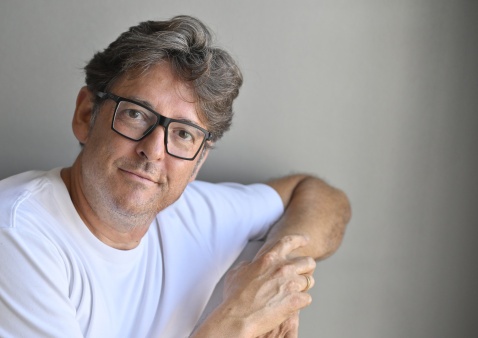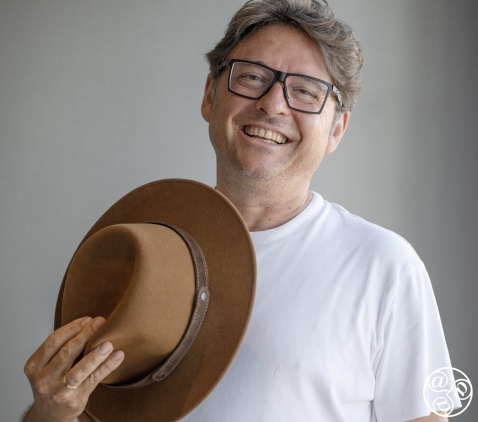
Francisco Alarcón © Michelle Chaplow |
|
Francisco Alarcón
Interview with Francisco Alarcón, official artist of the Estepona 2025 Feria poster
We spoke with Francisco Alarcón, a multidisciplinary artist from Estepona, who works in painting, sculpture, and mural art. Francisco studied Fine Arts at Seville University, and has worked and exhibited internationally, including in the US. Inspired by the Mediterranean light and scenes of his Costa del Sol hometown, this artist explores themes of memory, nature, and human connection in his works. His vibrant, large-scale murals inject colour and identity into urban spaces, and whether working on a public wall or a canvas, his art reflects a deep-rooted dialogue with place, tradition, and transformation. Francisco was commissioned to design the official poster for the 2025 Estepona Feria: his intriguing composition captures the Feria's energy and emotion in a fresh and contemporary way. We spoke to Francisco about the Esteponan elements featured in his poster, the importance of art in Andalusian life, and the role of public artworks in local communities.
Andalucia.com: Congratulations on being commissioned to design the 2025 Feria de Estepona poster. What does this commission mean to you?
Francisco Alarcón: It was an honour. The Feria, also known as the Fiesta Mayor, is the most important cultural event of the year in towns and villages across Andalusia and Spain. Being asked to capture that spirit in a poster is very special, as it evokes memories of my childhood and enables me to share the joy of the fair with my neighbours in Estepona and visitors to the fair.
AC: What inspired the design for this year’s Estepona feria poster?
FA: The Feria is an event made up of so many different elements, but the main theme is joy. To express all the elements, I chose a surrealist style in a carousel composition. The art of flamenco, bullfighting and Andalusian creativity are brought to life in this artwork. Human expression and colour take centre stage.
AC: Are there hidden symbols or cultural references in the poster that viewers might miss at first glance?
FA: Each character carries meaning and symbolism.
The woman in the red dress represents Estepona and the vibrant creativity of Andalusia. Her three arms are a surrealist expression of how women can take on many things at once—a visual metaphor for strength, multitasking and grace. As the lady gathers figs from the tree—our emblematic fruits, both higos and brevas—she playfully engages with the Church of Los Remedios, a tribute to how we cherish our heritage. The woman singing to the people is the wonderful local Flamenco singer, Rocío Bazán.
The clouds in the sky, include books to express knowledge and wisdom, which ties in with the old man strolling along the “Paseíllo” of the Calle Real in Estepona, beneath hundred-year-old trees.
The shadow on the whitewashed wall, is a Picasso-like shadow drawing, which is a tribute to our elders and their wisdom, to our universally renowned artist Pablo Picasso, a symbol of our age-old culture.
At the bottom of the poster—and at the heart of our Andalusian and Spanish society—is joy, represented by a young girl riding a carousel horse, depicted against the backdrop of the magical atmosphere of the Feria at night.
The poster’s background showcases the Sierra Bermeja mountains rising majestically behind Estepona, with the old town at its centre, the very heart of the town’s rich heritage.
AC: How does your cultural background and the essence of Andalucia influence your artistic work?
FA: I believe that for every artist, life experience lies deep within our visual soul—taking shape as colours, textures, and forms.
When I see an old house or a traditional Andalusian cortijo, or when I watch flamenco dancinn, I’m instantly moved. It stirs something within me, as an artist. I believe every artist’s work is inherently infused with their own cultural heritage.
AC: You’ve painted several public murals in Estepona with traditional motifs of fishing, family and religion. How does creating a feria poster compare to the larger community pieces?
FA: Both formats have a strong impact, as they reach a wide audience in different ways. A mural, because of its size and public setting, demands specific technical skills and methods, and it naturally invites public interaction.
Despite their differences, both the mural and the feria poster begin with the same foundation: historical and symbolic research, which is a key part of my creative process.
The main contrast lies in how they’re made. The poster is created in the quiet, personal space of the studio, while the mural is a more social experience, often shaped by spontaneous conversations and connections with the community. The people of Estepona have always shown me great kindness and generosity, which makes creating in public spaces especially meaningful.
AC: How do you want locals and visitors to feel when they see the poster?
FA:Each viewer will feel a different emotion, or perhaps nothing at all.
I truly enjoyed creating it, and I wanted to convey our joy and unique spirit of the Estepona feria.
AC: You studied Fine Arts at the University of Seville. How has your academic background shaped your artistic approach?
FA: The academic training at the Faculty of Fine Arts in Seville during the 1990s, when I studied there, placed strong emphasis on the values of traditional artistic education that had been passed down through centuries, where knowledge of the human figure and the visual language of drawing, painting, and sculpture were highly valued.
This perspective has been undeniably enriching and served as a springboard for exploring new fields.
AC: You’ve exhibited internationally - how have those experiences influenced your identity as an Andalusian artist?
FA: Travelling is a form of experimentation, and interestingly, this wealth of experience has made my Andalusian and Spanish heart shine through even more, infusing the works I’ve created outside my country, blending both cultures.
This happened during my artist residency in Connecticut, as well as in Morocco. I created a sculpture using recycled parts from American cars called “San Roque Jogging with His Dog”. In Morocco, I made two sculptures—“Don Quixote” and “Berber Woman”—both crafted from recycled pieces of boats from Estepona port and objects found in the Middle Atlas mountains.
AC: What role do public art and civic commissions play in preserving local memory and culture?
FA: Public art is essential; it is of vital importance.
“Art is the most common passion,” said Jean Dubuffet, and art in the streets is a social thermometer—it unites us, reminds us who we are as a society, encourages critical thinking, and fills us with creativity. In an increasingly technological world, it is absolutely essential.
AC: Do you see yourself working on more cultural or festival projects like this one in the future?
FA: I’d absolutely love to work on more cultural projects. There are moments when art really becomes part of the community’s rhythm, and they’re not just celebrations, they’re rituals. Being part of our community art world, is very meaningful to me.
AC: What advice would you give to young people in Andalucia hoping to engage with public or cultural institutions?
FA: Times have changed drastically since I graduated.
There are now highly advanced technological tools, and the world has become geographically closer, along with more connected personal and community relationships.
My advice would be to work hard and put genuine passion into everything you do. Take the time to educate yourself across different areas—both artistic and commercial—and keep an eye on what’s happening globally. That way, you can develop and express your own unique voice.
AC: What does art mean to you personally in the context of Andalucian life and community?
FA: Art is intrinsic to Andalusia.
We live outdoors, and life is in constant motion and communication.
Art is at the heart of Andalusia. We live much of our lives outdoors, and there’s a constant flow of movement and interaction. The Andalusian zest for life is an art form in itself, expressed through song, dance, writing, and painting. It’s also evident in key cultural events like Holy Week and the Feria — all of which are genuine living works of art.
AC: What is the best time of year in Estepona for you?
FA: Estepona has a wonderful geographical location, between the sea and the mountains. Each season of the year has its own special charm; I particularly enjoy Spring and Autumn, with their mild temperatures and the marvellous, unique southern light.
AC: What is your favourite restaurant in Estepona?
FA: My favourite places are Alma de Miguel, and La Escollera.
AC: Do you have a favourite Andalusian ingredient or special dish?
FA: Salmorejo, Gazpacho and Pescado al Espeto.
AC: What is your favourite place in Andalucia other than Estepona?
FA: Without a doubt, it has to be Seville. I studied and lived there and experienced the city in a very special way.
AC: In five words, what does Andalucia mean to you?
FA: Light, spirit, colour, love and fiesta!
More information about the work of Franciso Alarcón can be found at franciscoalarcon.com

